The Long Game Improvement Plan – Part 2
In this part of the report we’re going to look at the backswing, and we’ll start this by looking at…
The Take Away
The take away is super important because how you take the club away largely determines how consistent your ball striking will be.
You see, the consistency of your ball striking will only be as good as the downswing moves you make to get to impact. And the downswing moves you make to get to impact will only be as good as the transition moves you make. The transition you make will only be as good as your backswing, and your backswing will only be as good as your takeaway.
“The old maxim that the entire swing is governed by it’s first few inches is certainly true in my case. I can sometimes instinctively make midswing compensations to produce an effective shot after a poor start but, generally, when I start back incorrectly I hit a mediocre shot.”
Jack Nicklaus
And as Jack Nicklaus is quoted above, you can make compensations in your swing to hit the ball OK but you’ll be a better, more consistent golfer without forcing yourself to make in swing compensations if your take away is correct.
Sadly though, I see so many golfers taking the club away incorrectly, and by incorrectly what I really mean is with their hands. Instead of sweeping the club away with a one piece takeaway, most golfers pick it up with their hands. Doing this leads to all sorts of problems later in the swing and makes the golf swing a lot harder than it needs to be.
That’s why I teach my online students to work hard on perfecting a one-piece take away that is on plane, because that’s the easiest and simplest way to start the swing — and that makes the rest of the swing so much easier.
What is a one-piece take away?…you may be thinking.
Well, when you’re setup to a ball your shoulders and arms should form a slightly imperfect triangle like this:
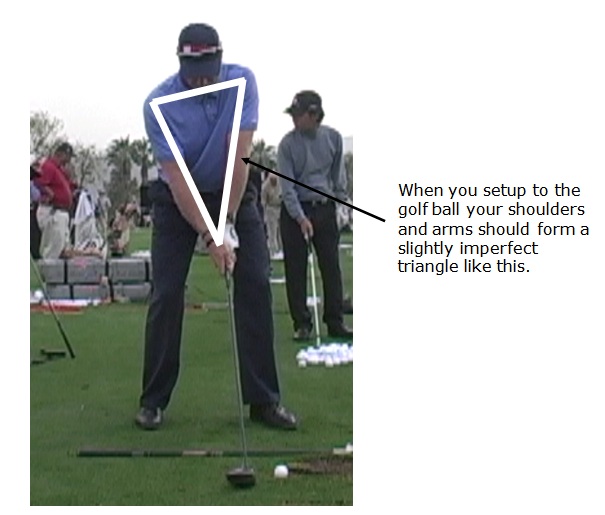
Then to start your backswing your shoulders should turn and when doing this your arms, hands and club should only move as a result of the turning of your shoulders. It’s very important when taking the club away that you do not manipulate your hands or wrists by hinging or rolling them.
Important Note: This triangle that is setup at address should remain intact until your left
hand is directly over your right leg. Because at that point the take away is complete.
When you have completed the take away the club has only moved 3 – 4 feet but it’s crucial that you get this part of the golf swing correct because it will make your golf swing a lot simpler and easier to repeat consistently.
That’s the one piece action covered but that’s not all there is to the take away, because when you take the club away from the ball you need to make sure it moves on an arc just inside the target line, NOT straight back along the target line.
Why?
Because a straight back take away gets the club traveling too much outside and causes your arms to become separated from the body. All of this will require compensations later in the golf swing which will result in inconsistent ball striking.
So you need to perfect the one-piece take away while taking the club away on the correct path.
Now at the same time as you’re taking the club away you need to…
Shift Your Weight
Once you’ve mastered the one piece take away you then need to combine that with the movement of shifting your weight to your right side at the beginning of your swing. This lateral shifting of your weight to the right means that your head, hips and shoulders ALL move to the right also.
Now we’re not talking about huge distances here. Only a couple of inches to the right by the time the club is parallel to the ground.
Also, please take special note that I said your head should also move to the right at the start of your swing. You don’t want it to remain still otherwise you run the risk of doing a reverse pivot and that’s disastrous.
Now when you move your weight to the right it must NEVER go to the outside of your right foot. Also this weight shift should occur very early in your backswing, i.e. once the club reaches a position where it is parallel with the ground all the weight shift that should occur in your backswing should have long taken place.
OK, that’s the take away covered. And again, it’s very, very important that you get the take away correct because everything else in the swing will be much easier if you do. All right, let’s now look at a…
Wide Swing Arc
To hit the golf ball as long as possible you MUST create a wide swing arc on your backswing. Now to do this your arms must NOT remain connected to your upper body after the take away has been completed.
Yes, you read correctly — your arms should disconnect/move away from your body as it continues to turn. If this doesn’t happen your backswing plane will be very flat and you’ll have a very narrow swing arc, costing you a lot of distance and probably causing a slice.
Now just to clarify a bit more what should be happening as you swing. You want your arms to be connected to your turning body for the take away. But once your hands reach a position where they are level with your right leg then your arms should start disconnecting/moving away from your turning body.
This is what creates the wide arc needed to hit the golf ball a long way.
Then when your club is parallel with the ground you want to make sure that the clubface is slightly closed. But this should not be as a result of any manipulation on your part. Because if you complete your setup and one piece takeaway correctly and then continue creating your wide arc then naturally the club should be slightly closed at this position in your swing…
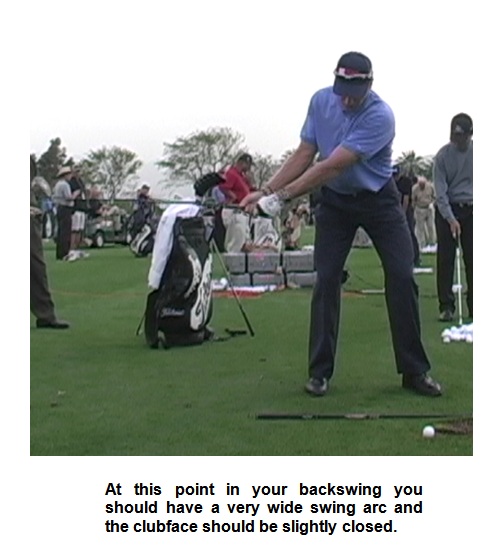
In the practice program I give my students they get a great drill to help them get into a position like being demonstrated above which naturally helps them to hit the ball a lot longer. Now continuing on from this backswing position….once your left arm is parallel with the ground, your left arm and club should form about a 100 degree angle like this…
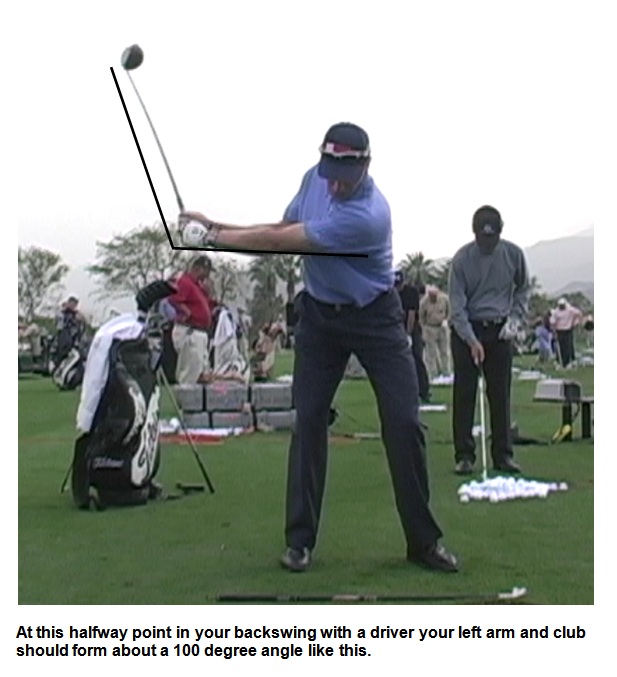
You see, the majority of the wrist cocking is done from the time the club is parallel with the ground until your left arm is parallel with the ground. From then on in the backswing there’s very little wrist cocking, it’s all basically turning.
Also, at this halfway point in the backswing you need to make sure your swing plane is correct. And in the backswing at the halfway point the butt end of your club should point at the ball or slightly inside. The swing plane is very important in the golf swing. If you get that right everything else in the swing will be a lot easier.
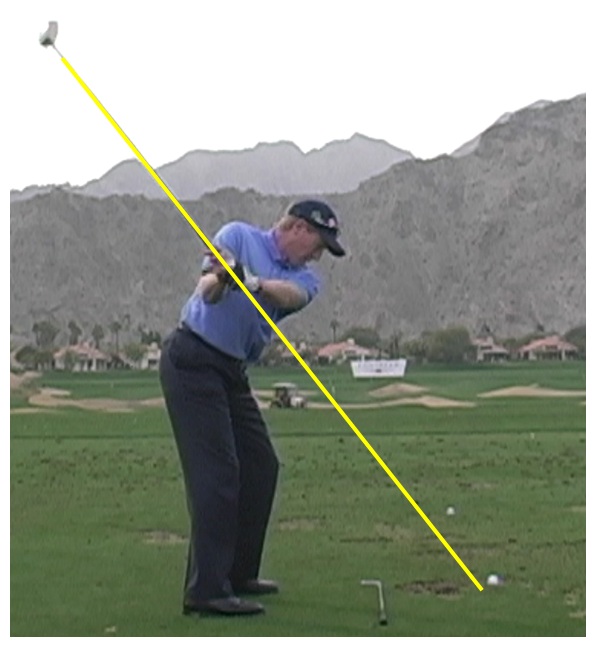
Now let’s look at your right leg and what that should be doing in your backswing because it serves a very important role.
The Right Leg
When you setup to a golf shot your right leg should have some flex in it . Then during your backswing there are three main things that can happen to your right leg:
- It can remain with the same flex throughout the entire backswing.
- It can remain flexed but straighten slightly from the setup position.
- It can straighten completely.
Unfortunately most golfers straighten their right leg completely on the backswing and this is a terrible mistake to make in the golf swing.
Why?
Because it causes a reverse pivot in the golf swing and as I’ve already said…that’s disastrous. So when you make your backswing you need to always have some flex in your right leg. That’s crucial.
OK, I’ve covered some very important things that need to happen in your backswing. Now I’m going to go over a quick summary of what should be happening in the backswing from the feet up.
Feet
Your left foot should not move at all during the backswing, and the majority of your weight should move to the heel of your right foot. Also, you must make sure that the weight does not move to the outside of the right foot during the backswing.
Knees
During the backswing the right knee should remain flexed. It doesn’t need to remain in exactly the same place as it was at address, but it must never completely straighten at any time in the backswing. Now with your left knee you should just let it move naturally where it wants to go during the backswing, you shouldn’t try to restrict it.
Hips
By the time your club is parallel with the ground your hips should have moved laterally to the right by a couple of inches. Doing this transfers most of your weight to your right foot. But remember, it must never go to the outside of your right foot. Then after that point the lateral shifting should stop and then the matter goes to turning the hips behind you. Doing this causes most of the weight to move to your right heel.
Spine Angle & Shoulders
The spine angle that is setup at address should be maintained during the backswing. You should not move your spine towards the ball or away from it as you’re swinging. And your shoulder rotation should be on a 90 degree angle (or near enough) to the spine angle at the top of the backswing.
Also, you want to turn your shoulders as far as they will go (keeping everything else the same). If you can get your shoulders to turn at least to 90 degrees that’s great, and even further would be a bonus. For example, Tiger Woods rotates his shoulders about 120 degrees!
Head
When you make your backswing your head should move to the right by a couple of inches. So don’t try and keep it still because if you do you run the risk of doing a reverse pivot and that’s not good. Also, your head shouldn’t move up or down at all in your backswing. It should pretty much maintain the same level throughout the entire backswing that it was at setup.
Arms
In the first part of the backswing the arms should do very little. Then your arms should reach away from the target to create a wide arc. During the backswing your left arm should remain pretty straight. It doesn’t need to be kept perfectly straight throughout the backswing, but as you complete your backswing your right arm should naturally bend so that at the top it is very bent. This should just happen naturally though.
Wrist Cock
At the half way point in your backswing your left arm and club should form about a 100 degree angle. Then at the top of your swing you want your left arm and club to form about a 90 degree angle. It doesn’t need to be exact, just pretty close to those numbers.
Swing Plane
When you take the club away your hands and club should move very close to the plane line. This will happen if you take the club away with a one piece take away and along the correct swing path.
Then when the club reaches a point where the club is parallel with the ground the club and hands should be close to the plane line. Now the most important check for the plane of the golf swing is once you’ve reached the position where your left arm is parallel with the ground. At this point you want the butt end of your club to point at the ball or slightly inside the ball. Then at the top of your swing (with the driver) your club should be aligned parallel with your target like this:
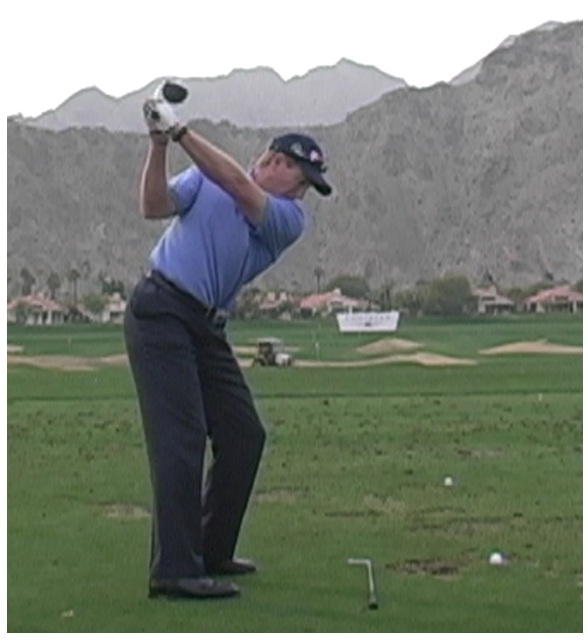
OK, let’s have a look at the clubface angle during the backswing.
Clubface Alignment
At the start of your swing the club should point directly at your target. Then at the point in the swing when the club is parallel with the ground your clubface should be slightly closed. At the top of your backswing the clubface should remain slightly closed.
OK, I’ve covered a lot of things that should happen in the backswing. But here are the three main things that are essential:
- Right Knee: Your right knee must maintain some flex in it during the backswing. If it completely straightens at any point in your backswing then you’ll be in trouble.
- Lateral Body Movement: During the backswing you must move your entire body laterally to the right by at least a couple of inches. If you don’t do this you’ll run the risk of doing a reverse pivot, which is a swing wrecker.
- Swing Plane: When you take the club away you need to have your hands and shaft very close to the plane line. Then at the half way point in your backswing the butt end of your club must point either at the ball or to the inside of the ball. If it points outside the ball your swing is much too flat.
That concludes Part 2 of this long game improvement plan. In Part 3 we’re going to look at the transition from backswing to downswing. There’s some very important information I share there. So keep an eye out for when I release that.

